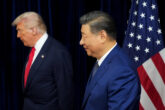October 26, 2023
The Quiet U.S. Revolution in AI Regulation
The headlines highlight the accepted conventional wisdom. “The Race to Regulate Artificial Intelligence: Why Europe Has an Edge Over America and China.” “Europe is Leading the Race to Regulate AI.” “The EU is leading the charge on AI regulation.”
Though the European Union is moving fast to pass its ambitious AI Act, the United States has also been advancing its own AI-related laws and broad governance efforts – in many ways at a much quicker pace than the EU. It’s critical to underscore this point for three main reasons.
Ultimately, the US approach serves as a solid foundation for enacting future legislation focused on the private sector AI actors as is currently being discussed in Congress.
- First, the US government’s AI legislative and regulatory efforts enhance its power to comment, critique, and push back on potentially counterproductive provisions in the AI Act and other artificial intelligence-related laws outside the US. A perception that the US government has done little undermines its authority — moral, technical, and otherwise — to opine effectively on other countries’ AI laws and lead in multilateral efforts such as the G7 Hiroshima Process.
- Second, the US approach, once clearly articulated, can be a model for countries to consider as an alternative or a complement to the EU’s AI Act. The AI Act – still in negotiation – has many virtues, but fundamentally, it is focused first on rules and second on how those rules will be defined, implemented, enforced, and evolved. By contrast, the US has emphasized building a regulatory infrastructure before moving to comprehensive regulation of AI products. Both models should be on the table.
- Third, the US government’s approach demonstrates a long-term and serious commitment to AI governance. Despite the challenging political environment in the US in recent years, both Democratic and Republican administrations and Democratic and Republican-led Congresses have championed AI governance efforts. The US government’s sustained focus on artificial intelligence shows allies and adversaries alike a clear commitment to act in the national interest.
Read the full article from CEPA.
More from CNAS
-
Transatlantic Security / Technology & National Security
Look Before We Leap on Artificial IntelligenceThis article was originally published on The Dispatch. A debate about the role that artificial intelligence should and will play in society, and how it will affect humanity fo...
By Jon B. Wolfsthal
-
Technology & National Security
Caleb Withers on the Cybersecurity Frontier in the Age of AICaleb Withers, research associate at the Center for a New American Security, joins Kevin Frazier, the AI Innovation and Law Fellow at the University of Texas School of Law and...
By Caleb Withers
-
Technology & National Security
Prepared, Not ParalyzedExecutive Summary The Trump administration has embraced a pro-innovation approach to artificial intelligence (AI) policy. Its AI Action Plan, released July 2025, underscores t...
By Janet Egan, Spencer Michaels & Caleb Withers
-
Indo-Pacific Security / Technology & National Security
Sharper: Tech + ChinaRecent talks between President Donald Trump and Chinese Communist Party General Secretary Xi Jinping placed a spotlight on emerging technologies, from high-end chips to minera...
By Charles Horn & Sevi Silvia




